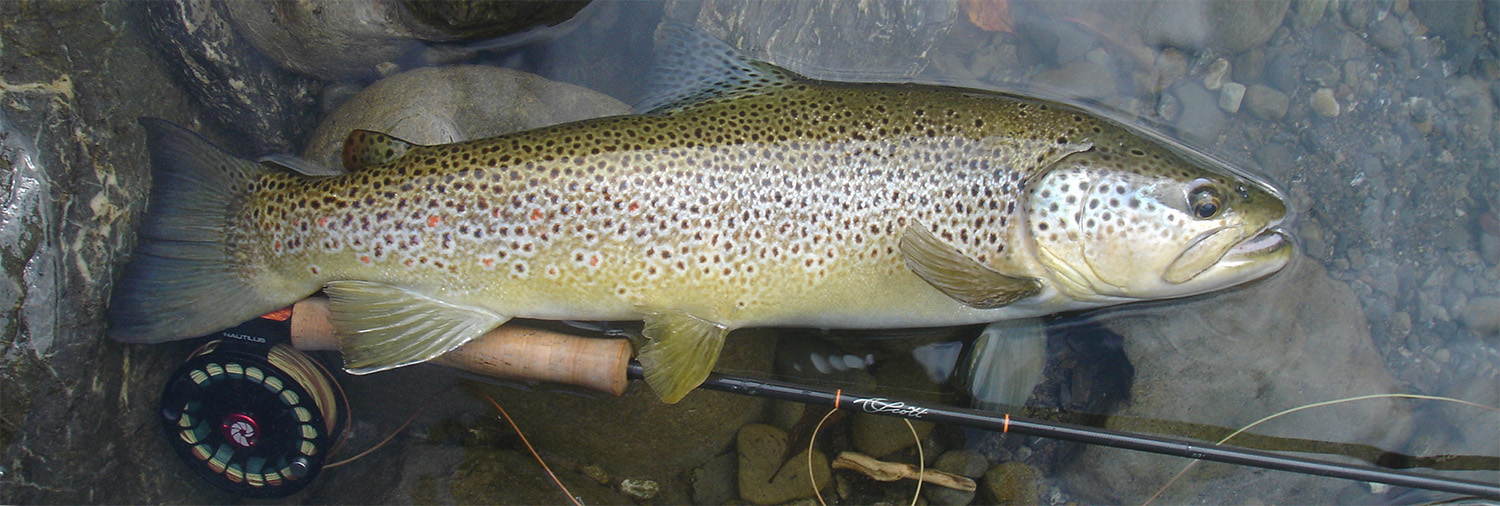My Scott S4s 9wt was my favourite fly rod for chasing kahawai from a kayak.
So I was excited when Scott brought out a new freshwater fly rod series in 2013, and especially when it won best fly rod and best product awards at the 2013 IFTD show in Las Vegas, USA.
The “fast meets feel” marketing slogan suggested the 5wt may have more feel in-close than my Hardy Zenith, making the Radian a more versatile rod. Fortunately the crew at Manic Tackle were able lend me a demo model for a couple of weeks in February 2014.
First Impressions
The finish and hardware on Scott’s top end rods are about as good as it can get. Scott rods have a pleasing hand crafted feel, which in the case of the Radian is accentuated by the hand-painted serial number and 12 and 20 inch length markers on the butt section.
As with the S4s series, Radian blanks are un-sanded and thread wraps are an appealing understated grey; although highlights on the Radian series are orange, instead of S4s blue, to match the hue of the dyed burled box-elder spacer in the self-indexing reel seat.
While the Radian uses the same titanium framed SiC stripping guide found on the Zenith, the rest are snake, instead of single foot guides, and the cork grip is a full wells instead of inverted half wells. For information on the technical aspects of blank construction check out the Scott website.
Apart from the aesthetic aspect of an un-sanded graphite blank, which I appreciate, the un-sanded finish has practical advantages on backcountry streams. Firstly, it reduces rod flash, and secondly the ridges actually protect the blank from scratches and nicks inflicted by boulders and rocks, usually sustained when slipping and falling, or when placing the rod down to release a fish.
When setting the Radian up alongside my Zenith I noticed it was a good inch and a half shorter. A tape measure confirmed the Radian was actually 8 foot 10.5 inches long, instead of 9 foot as indicated - not that it felt any shorter when fishing it.
On the water
I fished the Radian on two separate outings during the 2014 cicada season, landing a total of 33 backcountry brown trout up to six pounds. I used the same 5wt Airflo Bandit line, 15 foot leader and #8 Silicone Wing Cicada that I used on the Hardy Zenith.
The Radian 5wt is buttery smooth, like my 9wt S4s, and a real pleasure to cast at regular fishing distances. Although swing weights of the Zenith and the Radian are very similar, the Radian has a more progressive taper, being less tippy, resulting in considerably more feel and accuracy when casting to sighted targets within 50 feet. The 5 wt Radian and Bandit fly line proved to be a deadly combination for backcountry trout fishing when cicadas are about.
The Radian, nevertheless, lacks the explosive power of the Hardy Zenith, and those casts beyond 60 feet with big cicadas and heavy nymphs on 15 foot leaders, were not as easy - notwithstanding my casting ability.
Being slower than the Zenith, the Radian was also not quite as efficient at punching big dry flies into a headwind on a 15 foot leader, or at casting a size 8 Cicada with two weighted nymphs attached to the bend - a trick I use when fish fail to rise to the dry.
In saying this, I am by no means implying that the Radian is a close distance presentation tool, as it is a very versatile rod, it just does not do the long distance big fly stuff as well as the Zenith.
With a fish on, the Radian bends well into the butt section providing lots of shock absorption and a rod that fights the fish. Netting large brown trout on my own, was noticeably easier with the fully bent Radian than with the tippy Zenith.
I also prefer the smooth, relaxed experience of fighting fish with the likes of a Radian, over the high impact affair with a stiffer rod. But there were a few instances, when fish dashed for cover or over the rapids past the tail of a pool, that I missed the brutal head turning power of the Zenith.
To complete this review I tried casting smaller dry flies on the Hutt River, using an Airflo Tactical Ridge line, which is essentially a standard trout taper. Presentations in the calm conditions of slow pools and no wind, were consistently more delicate than I could achieve with the Zenith.
I also cast the Radian alongside my Loomis Streamdance, which was the best 5wt rod I owned for casting dry flies to sighted fish inside 50 foot. The Radian was a noticeably lighter swing weight, and it was a tad smoother and a little faster. This translated to marginally better feel and accuracy, an extra 5 or 10 feet, and better capability with heavier nymphs.
Conclusion
If I were asked which 5wt rod I would choose, a Radian or a Zenith, my answer would be both.
I’d use the Radian for mayfly hatches on lowland rivers and fishing the cicada season on backcountry and high country streams.
I’d use the Zenith for heavy nymphs, big rivers, lakes and windy conditions.
And if I had the misfortune to break either rod I would have a reliably solid backup, whatever the conditions.
But if I were pressed to choose just one rod, it would undoubtedly be the Radian, because it is a more versatile stick, especially for New Zealand conditions.
See other reviews :
